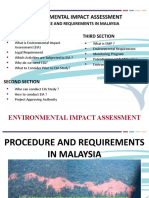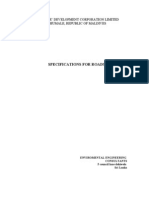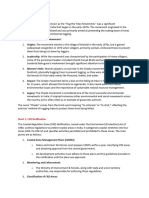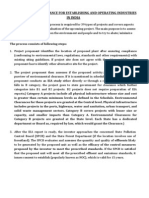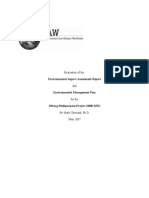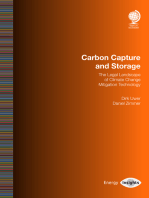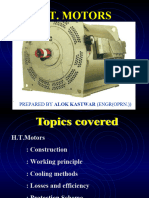0 ratings0% found this document useful (0 votes)
5 viewsEnvironmental Impact Assessment
Environmental Impact Assessment
Uploaded by
anakharnair24Environmental impact assessment
Copyright:
© All Rights Reserved
Available Formats
Download as PDF, TXT or read online from Scribd
Environmental Impact Assessment
Environmental Impact Assessment
Uploaded by
anakharnair240 ratings0% found this document useful (0 votes)
5 views9 pagesEnvironmental impact assessment
Original Title
EIA
Copyright
© © All Rights Reserved
Available Formats
PDF, TXT or read online from Scribd
Share this document
Did you find this document useful?
Is this content inappropriate?
Environmental impact assessment
Copyright:
© All Rights Reserved
Available Formats
Download as PDF, TXT or read online from Scribd
Download as pdf or txt
0 ratings0% found this document useful (0 votes)
5 views9 pagesEnvironmental Impact Assessment
Environmental Impact Assessment
Uploaded by
anakharnair24Environmental impact assessment
Copyright:
© All Rights Reserved
Available Formats
Download as PDF, TXT or read online from Scribd
Download as pdf or txt
You are on page 1of 9
ENVIRONMENTAL IMPACT ASSESSMENT
MODULE 2
1. ENVIRONMENTAL CLEARANCE PROCEDURE IN INDIA
It consists of the following processes:
• Start – Site selection: Project proponent identifies the location of proposed project after
ensuring compliance with existing siting guidelines. If project site does not agree with the siting
guideline, the proponent has to identify another alternative site for the project.
• Conduct of EIA: The project proponent then assesses if the proposed activity/project falls
under the purview of environmental clearance. If it is mentioned in schedule of the notification,
the proponent conducts an EIA study either directly or through a consultant. If the project falls
in B category, the project goes to state government for clearance which further categorise into
B1 and B2 projects. B2 projects do not require preparation of EIA reports. For every project,
possible alternatives need to be identified. Once the alternatives have been reviewed, a
mitigation plan supplemented with an environmental management plan (EMP) needs to be
drawn up for the selected option.
• Apply for NOC: After the EIA report is ready, the investor approaches the concerned State
Pollution Control Board (SPCB) and the State Forest Department (if the location involves use
of forestland). The SPCB evaluates and assesses the quantity and quality of effluents likely to
be generated by the proposed unit as well as the efficacy of the control measures proposed by
the investor to meet the prescribed standards. If the SPCB is satisfied, it issues consent to
establish (popularly known as NOC-No Objection Certificate), which is valid for 15 years.
• Public hearing: This provides a legal space for people of an area to come face-to-face with
the project proponent and the government and express their concerns. Public hearing is
conducted prior to the issue of NOC from SPCB. The District Collector is the chairperson of
the public hearing committee. Other members of the committee includes the official from the
district development body, SPCB, Department of Environment and Forest, Taluka and Gram
Panchayat representative, and senior citizen of the district, etc. The hearing committee hears
the objections/suggestions from the public and after inserting certain clauses it is passed on to
the next stage of approval (Ministry of Forest and Environment).
• Submission of documents: The project proponent submits an application for
environmental clearance with the MoEF if it falls under Project A category or the state
government if it falls under project B category. The application form is submitted with
EIA report, EMP, details of public hearing and NOC granted by the state regulators.
Environmental appraisal: The documents are first scrutinised by a multi-disciplinary staff
functioning in the Ministry of Environment and Forests who may also undertake site-visits
wherever required, interact with the investors and hold consultations with experts on specific
issues as and when necessary. After this preliminary scrutiny, the proposals are placed before
specially constituted committees of experts whose
• composition is specified in the EIA Notification. Such committees, known as
Environmental Appraisal Committees have been constituted for each sector such as
River Valley, Industries, Mining etc. and these committees meet regularly to appraise
the proposals received in the Ministry. The Appraisal Committees make their
recommendations for approval or rejection of particular projects. The recommendations
of the Committees are then processed in the Ministry of Environment and Forests for
approval or rejection.
• Issues of clearance or rejection letter: When a project requires both environmental
clearance as well as approval under the Forest (Conservation) Act, 1980, Proposals for
both are required to be given simultaneously to the concerned divisions of the ministry.
If the project does not involve diversion of forest land, the case is processed only for
environmental clearance.
2. FORM 1 – CATEGORY OF PROJECTS
Two schedules have been prepared which include the development categories that would
require an EIA. The development categories are divided into Schedule 1 and Schedule 2 as
per table below:
Schedule 1 includes larger scale projects and an EIA is compulsory.
Schedule 2 includes smaller scale projects but more sensitive in nature. It’s discretionary and
further criteria need to be assessed before deciding.
SCHEDULE 1 (23 CATEGORIES) SCHEDULE 2 (13 CATEGORIES)
1. Crude-oil refineries 1. Agriculture and aquaculture
2. Thermal/Nuclear power stations 2. Extractive industry
3. Installations for the reprocessing of
3. Energy industry
irradiated nuclear fuel
4. Integrated works for the initial
4. Production and processing of metals
smelting of cast-iron and steel
5. Installations for the extraction of
5. Mineral industry
asbestos
6. Chemical industry (unless included in
6. Chemical installations
Schedule 1)
7. Railways and airports with a basic
7. Food industry
runway length longer than 2,100 m
8. Textile, leather, wood and paper
8. Inland waterways & ports
industries
9. Waste disposal installations or landfill
9. Rubber industry
of hazardous waste
10. Waste disposal installations of non-
hazardous waste with a capacity 10. Infrastructure projects
exceeding 100 tonnes per day.
11. Transfer of water resources 11. Other projects
12. Waste water treatment plants 12. Tourism and leisure
13. Groundwater abstraction or artificial
13. Changes and extensions
groundwater recharge schemes
14. Extraction of petroleum and natural
–
gas for commercial purposes
15. Dams and other installations
designed for the holding back or –
permanent storage of water
16. Pipelines with a diameter of more
than 800mm and a length of more than –
40km
17. Installations for the intensive rearing
–
of poultry or pigs
18. Industrial plants for the production
–
of pulp or paper
19. Quarries and open-cast mining –
20. Construction of overhead electrical
–
power lines
21. Storage sites (geological storage of
–
carbon dioxide)
22. Installations for the capture of
–
carbon dioxide streams
23. Any change to or extension of
–
development listed in this Schedule
3. GENERIC STRUCTURE OF EIA REPORT
4. TERMS OF REFERENCE (ToR) (Case studies shared – Please check)
5. TYPES OF EIA :
STRATEGIC EIA (SEIA): Strategic EIA refers to systematic analysis of the
environmental effects of development policies, plans, programs and other proposed strategic
actions. This process extends the aims and principles of EIA upstream in the decision- making
process, beyond the project level and when major alternatives are still open. Strategic EIA
represents a proactive approach to integrate environmental considerations into the higher level
of decision-making.
REGIONAL EIA: EIA in the context of regional planning integrates environmental concerns
into development planning for a geographic region, normally at the sub- country level. Such
an approach is referred to as the economic-cum- environmental (EcE) development planning.
This approach facilitates adequate integration of economic development with management of
renewable natural resources within the carrying capacity limitation to achieve sustainable
development.
It fulfills the need for macro-level environmental integration, which the project-oriented EIA
is unable to address effectively. Regional EIA addresses the environmental impacts of regional
development plans and thus, the context for project-level EIA of the subsequent projects, within
the region. In addition, if environmental effects are considered at regional level, then
cumulative environmental effects of all the projects within the region can be accounted.
SECTORAL EIA: Instead of project-level-EIA, an EIA should take place in the context of
regional and sectoral level planning. Once sectoral level development plans have the integrated
sectoral environmental concerns addressed, the scope of project-level EIA will be quite narrow.
Sectoral EIA will help to address specific environmental problems that may be encountered in
planning and implementing sectoral development projects.
PROJECT LEVEL EIA: Project level EIA refers to the developmental activity in isolation
and the impacts that it exerts on the receiving environment. Thus, it may not effectively
integrate the cumulative effects of the development in a region.
RAPID ENVIRONMENTAL IMPACT ASSESSMENT(REIA): Rapid Environmental
Impact Assessment can be defined as the study, which is done for quick assessment of likely
adverse impacts. Rapid Environmental Impact Assessment studies will be conducted at the
initiation of the new activity. In some cases this study may be required for the expansion of
existing unit or change in the current manufacturing process (if the pollution load is to exceed
the existing one). Rapid Environmental Impact Assessment study covers one season baseline
data for various environmental components viz. Air, Noise, water, land, Biological and Socio-
economic including parameters of human interest.
COMPREHENSIVE ENVIRONMENTAL IMPACT ASSESSMENT: Comprehensive
Environmental Impact Assessment is basically a study which includes collection of data for
various components for four seasons i.e. Monsoon, Post-monsoon, Winter and Summer.
Comprehensive Environmental Impact Assessment report has to be submitted after the
evaluation of Rapid Environmental Impact Assessment report, if so asked by the Impact
Assessment Agency. Time scale is different for rapid and comprehensive EIA.
6. INITIAL ENVIRONMENTAL EXAMINATION IEE IN EIA STEPS
Screening is the process undertaken to decide which environmental assessment method is
required to be undertaken for a given project. It is the first step of EIA done to check its
requirement. This may be determined by size (eg: greater than a predetermined surface area of
irrigated land that would be affected, more than a certain percentage or flow to be diverted or
more than a certain capital expenditure). Alternatively, it may be based on site-specific
information. For example, the repair of a recently destroyed diversion structure is unlikely to
require an EIA whilst a major new structure may. Guidelines for whether an EIA is required
will be country specific depending on the laws or norms in operation. Legislation often
specifies the criteria for screening and full EIA.
The output from the screening process is often a document called an Initial Environmental
Examination or Evaluation (IEE). The main conclusion will be a classification of the project
according to its likely environmental sensitivity. This will determine whether an EIA is needed
and if so to what detail. Basically, it is mostly done using a list of criteria. The list is clearly
defined and contains detailed possible impacts.
Initial Environmental Examination (IEE) :
• Projects for which requirement of an EIA could not be easily ascertained is subjected to IEE.
• Assesses the severity of the significant issues and finds ways to mitigate or enhance
environmental impacts by considering the available information from past experience or the
standard operating practices.
• Required for small scale proposals.
• Minimum no of impacts are created.
• Potentially significant impacts are identified.
• Mitigation measures are prescribed.
Features Of IEE :
• Conducted with a limited budget
• Based on existing information
• Based on the professional judgment of people knowledgeable about impacts from similar
projects.
Requirements Of IEE Process:
• Adequate in-depth analysis than screening.
• Adequate technical input and advice from environmental specialists and experts. (so that
potential environmental issues can be clearly defined)
• Adequate amount of more resources and time.
IEE Process IEE process identifies:
• Most likely significant impacts (positive/negative) from proposed
• Measures for adverse impacts not expected to be significant.
• Mechanisms for enhancing beneficial impacts. Ex: local involvement, allocate fund for social
services.
• Residual uncertainties not possible to be resolved in the screening.
You might also like
- Dr. Rakesh KumarDocument34 pagesDr. Rakesh KumarEjo ShetNo ratings yet
- EIA Reference NotesDocument12 pagesEIA Reference NotesAarathi ManojNo ratings yet
- 02 Full EIA Mandatory ListDocument29 pages02 Full EIA Mandatory ListAbdirahman Aadan UrurNo ratings yet
- Standard TOR - Isolated StorageDocument8 pagesStandard TOR - Isolated Storageaftab_jamalNo ratings yet
- Project Formulation and AppraisalDocument36 pagesProject Formulation and AppraisalMadhumitha ThirumoorthyNo ratings yet
- Chapter 1Document22 pagesChapter 1nidNo ratings yet
- 01 Oct 2018 1658113200QUS76CUToR Distillery StandardDocument6 pages01 Oct 2018 1658113200QUS76CUToR Distillery StandardpipalatkarNo ratings yet
- EIA Procedure and Requirements in MalaysiaDocument56 pagesEIA Procedure and Requirements in MalaysiaWan RidsNo ratings yet
- CPT Environmental PresentationDocument108 pagesCPT Environmental PresentationJason LingNo ratings yet
- ToR CopyDocument7 pagesToR CopyUthradevi KannanNo ratings yet
- EIA Study and Report PreparationDocument52 pagesEIA Study and Report PreparationHarish KumarNo ratings yet
- 2.0 IdentificationofkeyissuesDocument17 pages2.0 IdentificationofkeyissuesPranay JainNo ratings yet
- Chapter 4Document18 pagesChapter 4nidNo ratings yet
- 3.env PolicyDocument16 pages3.env PolicyBharat MahajanNo ratings yet
- Environmental Impact AssessmentDocument16 pagesEnvironmental Impact AssessmentAditya Garg100% (1)
- Environmental Impact AssessmentDocument19 pagesEnvironmental Impact AssessmentbbnNo ratings yet
- Rohini 95473026083Document17 pagesRohini 95473026083CallMe WalkboyAP01No ratings yet
- C 9 E I A: C S: Hapter Nvironmental Mpact Ssessment ASE TudiesDocument162 pagesC 9 E I A: C S: Hapter Nvironmental Mpact Ssessment ASE Tudiesjazon fabian hpNo ratings yet
- Esia Unit 2 NewDocument23 pagesEsia Unit 2 Newvinoth KumarNo ratings yet
- Health, Safety & Environment Management - AssignmentDocument27 pagesHealth, Safety & Environment Management - Assignmentjobin.raj1989No ratings yet
- Environmental Compliance ChecklistDocument5 pagesEnvironmental Compliance ChecklistNIJESH100% (1)
- The Philippine Environment Impact Statement System and What It EntailsDocument20 pagesThe Philippine Environment Impact Statement System and What It EntailsIra CabualNo ratings yet
- EIA Scheme-Version 3 - Jun. 2015 - HRDocument20 pagesEIA Scheme-Version 3 - Jun. 2015 - HRRutuja GameyNo ratings yet
- EIA Procedure and Requirements in MalaysiaDocument56 pagesEIA Procedure and Requirements in Malaysiasarah adrianaNo ratings yet
- Chapter 1 IntroductionDocument18 pagesChapter 1 IntroductionRupas Kumar MeesalaNo ratings yet
- OVER SEAS, March, 2002: The Philippine Environment Impact Statement System and What It EntailsDocument15 pagesOVER SEAS, March, 2002: The Philippine Environment Impact Statement System and What It EntailsSam Sy-HenaresNo ratings yet
- Plant LayoutDocument21 pagesPlant Layouthitendra parmarNo ratings yet
- 5(f)IND2Document8 pages5(f)IND2rajesh kothariNo ratings yet
- Non-Technical Summary: Agence Régionale D'exécution Des Projets - AREP de Guelmim Oued NounDocument5 pagesNon-Technical Summary: Agence Régionale D'exécution Des Projets - AREP de Guelmim Oued NounHAMAINA AbdelouhabNo ratings yet
- Envm 8006a Lecture 2-Hk EiaDocument46 pagesEnvm 8006a Lecture 2-Hk EiasadgsgNo ratings yet
- DA2Document15 pagesDA2Arun KumarNo ratings yet
- Lecture 17. Environmental Impact AssessmentDocument34 pagesLecture 17. Environmental Impact AssessmentDutchsMoin Mohammad100% (1)
- Road Work SpecificationsDocument71 pagesRoad Work SpecificationsAbdulla NaushadNo ratings yet
- Lect 8 IEE EIA Requirment Spring 2021 (Edited)Document37 pagesLect 8 IEE EIA Requirment Spring 2021 (Edited)Smart JhnzbNo ratings yet
- Lecture-8-Evolution of Eia in India-31012013Document39 pagesLecture-8-Evolution of Eia in India-31012013Ravi ShankarNo ratings yet
- CHAPTER6 Environmental ComplianceDocument6 pagesCHAPTER6 Environmental ComplianceAbella, Yahoney B.No ratings yet
- Toxicology CatDocument11 pagesToxicology CatjanesNo ratings yet
- 4081-01-WTPS Iraq Oil Terminal Non Technical Summary Arabic-Rev-00 - (10-24-2014)Document110 pages4081-01-WTPS Iraq Oil Terminal Non Technical Summary Arabic-Rev-00 - (10-24-2014)Ezzadin BabanNo ratings yet
- EIA - Impacts and Mitigation Measure On WaterDocument23 pagesEIA - Impacts and Mitigation Measure On WaterAbhinav AbhiNo ratings yet
- Environmental Impact Assessment of Mining Projects: Dr. Gurdeep Singh 1.0 ScreeningDocument10 pagesEnvironmental Impact Assessment of Mining Projects: Dr. Gurdeep Singh 1.0 ScreeningSureshRichards100% (1)
- Scoping - Eia: Bhavani .V Project Faculty Nabet Approved Expert (EIA Coordinator, AP & WP)Document22 pagesScoping - Eia: Bhavani .V Project Faculty Nabet Approved Expert (EIA Coordinator, AP & WP)Mot EmbyNo ratings yet
- Proposal To Establish An Industrial PaikDocument26 pagesProposal To Establish An Industrial PaikFuadNo ratings yet
- 2 - Eia - PD 1586Document196 pages2 - Eia - PD 1586Vitaliano Francia, Jr. IINo ratings yet
- Draft EIA Bill (May 2020)Document8 pagesDraft EIA Bill (May 2020)Pura Vita PedrosaNo ratings yet
- 6 Monthly ComplianceDocument26 pages6 Monthly Compliancevaishnavi dhinakaranNo ratings yet
- Environment Clearance ProcessDocument10 pagesEnvironment Clearance ProcessAbhishek SharmaNo ratings yet
- Northampton Scoping Report (2016)Document42 pagesNorthampton Scoping Report (2016)Manuel CórdovaNo ratings yet
- EIA-1054MAKINDU-FILLING-STATION-pdf - Environmental Impact Assessment Study Report, 2013Document63 pagesEIA-1054MAKINDU-FILLING-STATION-pdf - Environmental Impact Assessment Study Report, 2013handsam84No ratings yet
- Draft DAO Revised SAPA GuidelinesDocument11 pagesDraft DAO Revised SAPA GuidelinesStaff of Gov Victor J Yu100% (2)
- Module 2-7 - Environment and Natural ResourcesDocument18 pagesModule 2-7 - Environment and Natural ResourcesAlwyn RamosNo ratings yet
- September - 2020 - Environmental - Impact - Assessment ResarchDocument26 pagesSeptember - 2020 - Environmental - Impact - Assessment Resarchboussaidy609No ratings yet
- Terms of Reference For EIA PreparationDocument257 pagesTerms of Reference For EIA PreparationSachin VasudevaiahNo ratings yet
- Walker Planning SubmissionDocument7 pagesWalker Planning Submissionapi-425120971No ratings yet
- Environmental Law AssignmentDocument22 pagesEnvironmental Law AssignmentsalomanNo ratings yet
- Environmental ClearanceDocument4 pagesEnvironmental ClearanceTanvi JainNo ratings yet
- Eia Re 1Document14 pagesEia Re 1Greeshma KrishnanNo ratings yet
- CIL Corporate Environmental Policy 2018Document9 pagesCIL Corporate Environmental Policy 2018Ashutosh MondalNo ratings yet
- Environment (Protection) Act, 1986Document7 pagesEnvironment (Protection) Act, 1986Shivangi BajpaiNo ratings yet
- Carbon Capture and Storage: The Legal Landscape of Climate Change Mitigation TechnologyFrom EverandCarbon Capture and Storage: The Legal Landscape of Climate Change Mitigation TechnologyNo ratings yet
- Green hydrogen for industry: A guide to policy makingFrom EverandGreen hydrogen for industry: A guide to policy makingNo ratings yet
- R800LC-9 MaintananceDocument33 pagesR800LC-9 MaintananceJorge RojasNo ratings yet
- Physics Formula Sheet Unit 2Document1 pagePhysics Formula Sheet Unit 2sadika sabaNo ratings yet
- 21 Alexey Mikhaylov Nikita Moiseev 2 Kirill Aleshin 3 Thomas Burkhardt 4Document18 pages21 Alexey Mikhaylov Nikita Moiseev 2 Kirill Aleshin 3 Thomas Burkhardt 4Ismael AnconaNo ratings yet
- ElectronicIgnition BC PPT PreFINALDocument4 pagesElectronicIgnition BC PPT PreFINALSRI .. VECTORNo ratings yet
- HPM Chapter1 PDFDocument38 pagesHPM Chapter1 PDFsiddhartha2862No ratings yet
- UPS12-280R MRX: Valve Regulated Lead Acid BatteryDocument2 pagesUPS12-280R MRX: Valve Regulated Lead Acid BatteryMuneer AhamedNo ratings yet
- Pi - Pentosin Eg FFL-7 ADocument3 pagesPi - Pentosin Eg FFL-7 AdnoaisapsNo ratings yet
- Magnetism JIDocument19 pagesMagnetism JIMahadi HasanNo ratings yet
- Design and Evaluation of An Hammer MillDocument49 pagesDesign and Evaluation of An Hammer MillIsrael AireNo ratings yet
- SX4 2008Document142 pagesSX4 2008Johnny Chaves Brenes100% (1)
- Class11th Physics Chapterwise MCQs New PatternDocument168 pagesClass11th Physics Chapterwise MCQs New Patternchinnasamy8103No ratings yet
- HT MotorsDocument66 pagesHT MotorsAnoop Kumar Allanki100% (1)
- Sessional Quiz QuestionsDocument1 pageSessional Quiz Questionsshamiul himelNo ratings yet
- TG-ETC Approved BBU Release-2Document46 pagesTG-ETC Approved BBU Release-2Prabir PalNo ratings yet
- Process Control: Pcchp4Document25 pagesProcess Control: Pcchp4Can TekinalpNo ratings yet
- 06 Circular Motion Tutorial SolutionsDocument6 pages06 Circular Motion Tutorial SolutionsMe4d SHiV23No ratings yet
- Binangonan Sub-Office: Republic of The Philippines Department of Education Region Iv-A Calabarzon Division of RizalDocument7 pagesBinangonan Sub-Office: Republic of The Philippines Department of Education Region Iv-A Calabarzon Division of RizalArenas Jen100% (1)
- Lecture-note-Renewable EnergyDocument3 pagesLecture-note-Renewable EnergyMuhammad Tahmid HossainNo ratings yet
- Module 17 Propellers Test AnswerDocument4 pagesModule 17 Propellers Test AnswercamapnhiNo ratings yet
- CV Pak Budi P...Document2 pagesCV Pak Budi P...syamsul zamriNo ratings yet
- Financial Times UK April 22 2021Document24 pagesFinancial Times UK April 22 2021Kenzie MorissonNo ratings yet
- SiteDevelopmentPlanDraft EnglishDocument79 pagesSiteDevelopmentPlanDraft EnglishImjusttryingtohelpNo ratings yet
- Lapp Kabel H05V-K: Power and Control CablesDocument1 pageLapp Kabel H05V-K: Power and Control CablesJemerald MagtanongNo ratings yet
- Cambridge IGCSE: PHYSICS 0625/42Document16 pagesCambridge IGCSE: PHYSICS 0625/42EffNo ratings yet
- Schema Electrique HA41PX GBDocument14 pagesSchema Electrique HA41PX GBNam NguyễnNo ratings yet
- Natural ResourcesDocument8 pagesNatural ResourcesTigerNo ratings yet
- Challenges of LPG Supply, Distribution and Pricing in Growing Market: Bangladesh Case StudyDocument19 pagesChallenges of LPG Supply, Distribution and Pricing in Growing Market: Bangladesh Case Studymitu lead01No ratings yet
- ME 372 (Chapter-7) - External Forced ConvectionDocument53 pagesME 372 (Chapter-7) - External Forced Convectionالياس يونس مرغلانيNo ratings yet
- Physics Grade 11 Unit 5 SummaryDocument39 pagesPhysics Grade 11 Unit 5 SummarysapphireNo ratings yet
- ISO-7-E Fault Isolator Module: GeneralDocument2 pagesISO-7-E Fault Isolator Module: GeneralBui LyNo ratings yet








